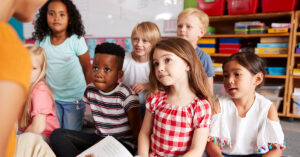Why is supporting oral language awareness important in literacy learning?
Oral language provides a base of understanding for written language.
Oral language serves as a tool for learning and thinking. An ever-extending oral language base allows us to communicate effectively in a variety of settings, whether this communication occurs in conversations across our day or when interacting with written texts in a classroom setting.
For young literacy learners, becoming aware of language begins with an awareness of the oral structures of language. An intentional awareness of language often begins with language “play”—when caregivers draw attention to the sounds of language during their interactions with the child, demonstrating how the sounds of language can be discerned, relished, and manipulated. Imagine a child experiencing the opening lines to this classic song with its well-known movements: “The itsy, bitsy spider went up the water spout; down came the rain and washed the spider out.” The first rhyme of the song—itsy, bitsy—invites the child into the familiar song and brings the first joyful smile as the child manipulates their fingers to mimic the spider climbing up the spout. The later rhyme of spout and out continues to support children to “hear” the language. As the swooshing motion accompanies “washed the spider out” occurs, the associated movement easily and effortlessly draws attention to the onomatopoeia inherent in many well-known rhyming poems used with young children. Singing, rhyming, clapping, hand and body motions, and other traditional (and fun!) ways of interacting with songs and poems bring oral language awareness to life.
In the classroom, using (and reusing) songs, poems, rhymes, and other chants develops and extends students’ oral language awareness with an eye towards written language awareness. When teachers focus on rhythm and rhyming intrinsic in known songs and poems, students become aware of expressive elements of how language sounds, such as loud and soft, fast and slow (also found in fluent reading). Students quickly recognize which words are emphasized in certain, specialized ways as teachers use and reuse familiar songs and poems (also a helpful understanding as students read and write their own texts). Through clapping their hands or snapping their fingers as they sing along, students become increasingly aware of words and syllables (also a necessary understanding for decoding when reading and encoding when writing). All these ways of interacting with a song or poem in the oral tradition promote the awareness of oral language which underlies all literacy learning.
In Flying Start to Literacy: PHONICS™, from Okapi Educational Publishing, The Big Book of Rhymes provides a collection of original songs, poems, and chants, adding a fresh resource for teachers to use to increase oral language awareness. In Stage One of the program, each letter of the alphabet is introduced using a song, poem, or chant from The Big Book of Rhymes to illustrate the key letter being taught in the unit. In Stages Two and Three of the Phonics program, a collection of traditional songs, poems, and other rhymes are included in the Teacher Resource Book to use in similar ways, encouraging and extending the use of rhythmic texts to support oral language awareness.
Teacher notes found in all three Stages recommend teachers sing or chant the rhyme as it is read, having students join in on repeated singing, chanting, or reading of the text. In this subsequent singing, chanting, or reading, teachers and students interact with the song, poem, or chant using methods from the oral tradition, i.e., using the voice and movements to highlight and emphasize particular sound elements. For example, in Stage One, the song Fuzzy Little Caterpillar is sung to the tune of Itsy Bitsy Spider. Teachers are asked to stress the /k/ sound, or phoneme, in the words caterpillar, curled, and chrysalis as they sing the song (later, students attend to the grapheme c). Inviting students to sing along, teachers draw attention to syllables by having students clap their hands or tap or snap their fingers as the song is sung together. Later on, in Stage Two, using the traditional song Row, Row, Row Your Boat, teachers emphasize the long /o/ vowel sound, or phoneme, in row and boat (with an eye towards attending to the graphemes oa and ow later in the unit). Again, as students sing along to this well-known song, attention to the words and syllables heard becomes apparent as students clap, tap, or snap to the rhythm they are experiencing. All of these traditional ways of interacting with a rhythmic text increase students’ oral language awareness.
Using songs, poems, and chants increases students’ oral language awareness—rhyme, rhythm, words, syllables, phonemes—which in turn supports their written language awareness. Oral and written language awareness is critical to all literacy learning.
Use songs, poems, and chants with students right from the start to support their oral language awareness! Debra Crouch.

